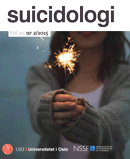Självet och suicidaliteten
DOI:
https://doi.org/10.5617/suicidologi.2382Abstract
SAMMANFATTNING
Den psykiatriska sjukdomsmodellen är inte någon bra modell för
att förstå suicidalitet. I denna uppsats prövar vi möjligheten av att i
stället se självmord som ett mord på självet. Självets utveckling, dess forsvarsmekanismer och revir skisseras. Det moderna västerländska samhället är på många sätt felkonstruerat, vilket ständigt producerar lidande. Personer med suicidalitet skall ej i första hand uppfattas som offer utan som tappra hjältar och nödvändiga informatörer. Deras erfarenheter kan öka vår medvetenhet och bidra till att denna jord blir en något bättre plats att leva på.
ENGELSK ABSTRACT
The model of mental disorders is not adequate in understanding
suicidality. In this paper we investigate the possibility to perceive
suicide as a murder of the self. We describe the development of the
self, its defense mechanisms and its territories. The modern western
society is in many respects constructed in a deficient way, which
continuously results in suffering for its members. Suicidal persons
shall not be comprehended as sacrifices but as brave heroes and
important informants. Their experience can increase our awareness
and contribute to the efforts making this earth a somewhat better
place to live in.
Referenser
Andersson, P. Medmänniskans outhärdliga grymhet. Recension av filmen Smärtgränsen i regi av Michel Franco. Göteborg-Posten 2013-09-12.
Beskow, J., Palm Beskow, A., Ehnvall, A. (2013). Suicidalitet som problemlösning, olyckshändelse och trauma. Lund: Studentlitteratur.
Beskow, J. (2012). Samhällets lidandeproduktion och behov av resiliens. Psykisk Hälsa, 2012:2. Årgång 53.
Broberg, A., Granqvist, P,. Ivarsson, T., Risholm Mothander, P. (2006). Anknytningsteori. Betydelsen av nära känslomässiga relationer. Stockholm: Natur och Kultur.
Christakis, N., Fowler, J. (2011). Connected. The amazing power of social networks and how they shape our lives. London, Harper Press.
Damasio, A. (2010). Self comes to mind. Constructing the conscious brain. London: William Heineman. Svensk upplaga: Du och din hjärna. Så skapar hjärnan ditt medvetande. Sundbyberg: Pagina Förlags AB/Optimal Förlag 2010.
Geertz, C. (1973). The interpretation of culture. New York, Basic Books. Citerat från Wasserman C. (2009). Suicide. Considering religion and culture, i Wasserman D, Wasserman C. Oxford Textbook of Suicidology and Suicide
Prevention – A Global Perspective. Oxford: Oxford University Press.
Guidano, VF. (1991). The Self in process. Toward a post-rationalis cognitive therapy. London: The Guilford press.
Gyllensten, K., Palm Beskow A., Palmer S. (red) (2011). Psykologisk coaching för varaktig förändring. Stockholm: Natur och Kultur.
Hellström, O. (2013). Yvette, 20, stoppad i patientkarriären. Läkartidningen,
(36): 1554–1555.
Johnson, T., Palm, M., Jansson, H. m.fl (30.09.2013). Låt inte budgetdisciplin gå före mänskliga värden. Göteborgs-Posten Debatt.
Kahneman, D. (2013). Tänka snabbt och långsamt. Stockholm: Volante.
Keyes, C., Haidt, J. (2003). Flourishing. Positive psychology and the life welllived.
Washington: American psychological association.
Larsson, I., Palm, L., Rahle Hasselbalch, L. (2008). Patientkommunikation i praktiken. Stockholm: Norstedts förlag.
Levine, P., Kline, M. (2008). Trauma-proofing your kids. A parents’ guide for instilling confidence, joy and resilience. Berkeley. North Atlantic books.
Levine, P. (2010). In an unspoken voice. How the body releases trauma and restores goodness. Berkeley. North Atlantic books.
Metzinger, T. (2009). The Ego Tunnel. The science of the mind and the myth of the self. New York: Basic books.
Michel, K., Maltsberger, JT., Jobes, DA. et al. (2002). Case Study. Discovering the Truth in Attempted Suicide. American Journal of Psychotherapy, 56: 424–37.
Monitor (2013). Osignerad nyhetsartikel, Monitor on Psychology, American psychological association, October, 44 (9):15.
Nyberg, U. (2013). Konsten att rädda liv. Stockholm: Natur och kultur.
Ogden, P., Minton, K. (2006). Pain C. Trauma and the Body. A Sensorimotor Approach to Psychotherapy. London: Norton o Co.
Sheldon, K. M., Williams, G., Joiner, T. (2003). Self-determination theory in the clinic. Motivating Physical and Mental Health. New Haven: Yale University Press.
Siegel, D.J. Mindsight (2011). The new science of personal transformation. New York: Bantam books Trade Paperbacks.
SKL. (2011). Råd för bättre kommunikation mellan patient och vårdpersonal. Sveriges kommuner och landsting. Beställ eller ladda ner från www.skl.se/publikationer. Best.nr. 5236.
Stern, D. (2005). Ögonblickets psykologi. Om tid och förändring i psykoterapi och vardagsliv. Stockholm: Natur och Kultur.
Stern, N. (2013). Nätverket Ethikheute. Ethikheute –Magasin für achtsames
Leben, www.ethik-heute.org
Suicidprevention i Väst, SPIV. Vägen bort. Suicidalitet som problemlösning. Tre DVD-filmer varav en: Samtal efter ett suicidförsök redan är producerad. Introduktion
och Studievägledning ingår. Göteborg: Suicidprevention i Väst, 2013. Se www.suicidprev.com
Tallaksen, D. W. (2009). Intervju av Ellen B. Brodtkorb og Esben B-J Jaer. Suicidologi; 14 (2):7.
Weir, K. (2013). New research sheds light on how toddlers map their surroundings. Monitor on Psychology, American psychological association, October 2013, 44 (no. 9):13.
Williams, M. (2001). Suicide and attempted suicide. Understanding the cry of pain. London: Penguin Books.
Downloads
Nummer
Sektion
Licens
Dette tidsskriftet gir umiddelbar og fri tilgang (Open Access) til tidsskriftets innhold, ut fra det prinsipp at det å gjøre forskning fritt tilgjengelig for allmennheten gir økt global utveksling av kunnskap.
Forfattere som publiserer i dette tidsskriftet aksepterer følgende vilkår:
1. Forfatter beholder opphavsrett til sine verk i henhold til Åndsverkloven, og gir Suicidologi rett til første publisering av et verk.
2. Forfatter kan inngå separate tilleggsavtaler om ikke-eksklusiv distribusjon av den publiserte utgaven av sine artikler (f.eks. levere den inn til et institusjonelt publiseringsarkiv) så lenge Suicidologi blir kreditert som første utgiver.
3. Leseres bruk av tidsskriftet må skje i tråd med Åndsverkloven.


